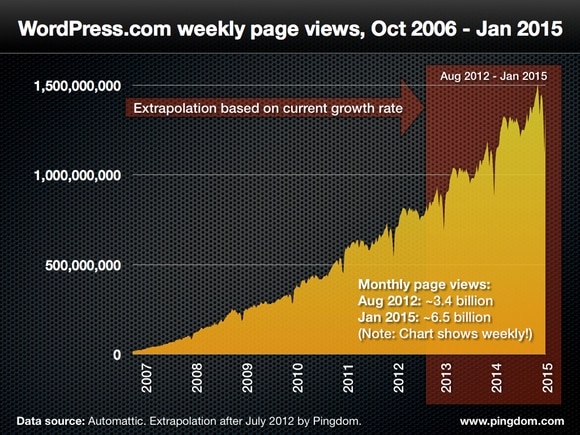![]() Automattic’s WordPress.com blog hosting platform just keeps growing. Traffic is up 25% compared to a year ago, and 79% compared to the year before that. It hosts around half of all WordPress sites in the world (of which there are currently 54.7 million)
Automattic’s WordPress.com blog hosting platform just keeps growing. Traffic is up 25% compared to a year ago, and 79% compared to the year before that. It hosts around half of all WordPress sites in the world (of which there are currently 54.7 million)
It’s easy to forget how it started, as a small service by the people behind the open source WordPress blog software. Here is Matt Mullenweg’s short announcement from back in November of 2005, when WordPress.com was opened up for everyone:
We’ve decided to open up WordPress.com for signups without invites for a bit. The service has been scaling very well since we got the problems from the move worked out. With that done and WordPress 2.0 in its final stages, there is a lot more time to focus on some cool features and common requests for WP.com now. (The design there has been updated, but is still just a placeholder.)
A year later, WordPress.com was handling north of 90 million page views per month. But that was back in 2006; today the blog service handles 37x more traffic, around 3.3-3.4 billion page views per month.
Using the past to predict the future
How much traffic will Automattic’s blog service be handling over the next couple of years? We extrapolated those numbers based on current year-over-year growth, and this is the result (unless something drastic happens):

Busy little bees, those servers. 🙂
Ups and downs, why?
Aside from the obvious overall growth, a couple of things stand out:
- Each summer (for the northern hemisphere) sees a lull in traffic.
- There is a sharp dip in traffic over Christmas and New Years.
This is interesting because that pattern is probably similar for blogs in general. It’s most likely a combined effect of two things: Fewer blog posts are produced, and fewer people are glued to their computers.
Thumbs up
Hopefully you enjoyed this little mini-investigation of the traffic to WordPress.com.
We have to finish this be extending our congratulations to Matt Mullenweg and the Automattic team for launching and growing such a successful blog hosting platform. An achievement to be proud of!
Data source: Weekly traffic to WordPress.com sites.
Extrapolation method: Year-over-year weekly traffic growth is around 27.4% if you average the entire year so far. We used that number to estimate what traffic might look like the coming years (assuming each week has 27.4% more traffic than the same week a year ago).
Want that chart but bigger? Here you go.
























